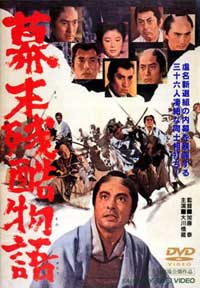 This 1964 black and white samurai film bleeds blood red in violence and anger thoughout its 90+ minutes. It depicts the Shinsengumi clan (a group of samurai dedicated to the preservation of the Tokugawa government) and their closed and brutal world where recruits have to undertake a kill or be killed initiation swordfight. One young man, Enami, is starstruck by their prior accomplishments and decides to join them, though he shows his nativety in all aspects of becoming a warrior. He and the other recruits witness a beheading, and tries not to throw up. In training he is almost pummeled senseless by one of the ruthless superiors. When asked to perform a beheading he practically botches the job, hacking the man to pieces. He clearly is not of samurai stock, but manages to survive the training. Sato (played by Junko Fuji, who is known for her starring role in the Red Peony Gambler series), a maid who is part of a group of servants left behind by the original owners of the facility, takes to him because of his innocence. Over time though, he becomes more adept with the sword, especially with beheadings. While the Shinsengumi is preparing to head off to battle, they spend a lot of movie time rooting out spies, rule breakers and those with a conscience. It is not a pretty place. There is homosexuality among some members, and others frequent the brothels for some action. Enami and Sato couple in the warehouse the evening before the battle, while the others get inebriated. Sato wonders why he is in this place, and later we find out: he is actually the nephew of a man who was the original head of the Shinsengumi, assassinated by the current leader. The boarded house in the facility was where he was killed with his woman, shown in a great expressionist flashback sequence. Sato proposes to Enami before he is about to leave, and he is suddenly called away to see the leader. They expose his past, and he does not deny it. In a terrific fight sequence, Enami battles for survival as he rushes to escape, but is cut down by his one friend whom he thought shared the same feelings about the cruelty of the clan. Sato cries over Enami's corpse in the alley, while his friend angrily slashes the written code of the Shinsengumi, then prepares to join the others for war.
This 1964 black and white samurai film bleeds blood red in violence and anger thoughout its 90+ minutes. It depicts the Shinsengumi clan (a group of samurai dedicated to the preservation of the Tokugawa government) and their closed and brutal world where recruits have to undertake a kill or be killed initiation swordfight. One young man, Enami, is starstruck by their prior accomplishments and decides to join them, though he shows his nativety in all aspects of becoming a warrior. He and the other recruits witness a beheading, and tries not to throw up. In training he is almost pummeled senseless by one of the ruthless superiors. When asked to perform a beheading he practically botches the job, hacking the man to pieces. He clearly is not of samurai stock, but manages to survive the training. Sato (played by Junko Fuji, who is known for her starring role in the Red Peony Gambler series), a maid who is part of a group of servants left behind by the original owners of the facility, takes to him because of his innocence. Over time though, he becomes more adept with the sword, especially with beheadings. While the Shinsengumi is preparing to head off to battle, they spend a lot of movie time rooting out spies, rule breakers and those with a conscience. It is not a pretty place. There is homosexuality among some members, and others frequent the brothels for some action. Enami and Sato couple in the warehouse the evening before the battle, while the others get inebriated. Sato wonders why he is in this place, and later we find out: he is actually the nephew of a man who was the original head of the Shinsengumi, assassinated by the current leader. The boarded house in the facility was where he was killed with his woman, shown in a great expressionist flashback sequence. Sato proposes to Enami before he is about to leave, and he is suddenly called away to see the leader. They expose his past, and he does not deny it. In a terrific fight sequence, Enami battles for survival as he rushes to escape, but is cut down by his one friend whom he thought shared the same feelings about the cruelty of the clan. Sato cries over Enami's corpse in the alley, while his friend angrily slashes the written code of the Shinsengumi, then prepares to join the others for war.Directed by Tai Kato, this fast moving film hits you hard with its no nonsense, gritty depiction of a closed world of violence and trechery. Unlike any other samurai film of its day, the fight scenes are not carefully choreographed, but chaotic and brutal. Men stumble, slash away at empty air, bump into each other. The paranoia of the leaders in maintaining their position is enforced by the tightly packed rooms that they live and work in -- the screen is dense with people. Only with Sato is there privacy and space. This was apparently a low budget film that clearly rose above its limitations with solid acting and a good story. The camerawork is fantastic, deftly making the viewer feel the action rather than just watching it -- Enami's death scene is harrowing and unexpectedly graphic for its time, but it is shown only in a punctuated still rather than in motion. Highly recommended!


No comments:
Post a Comment